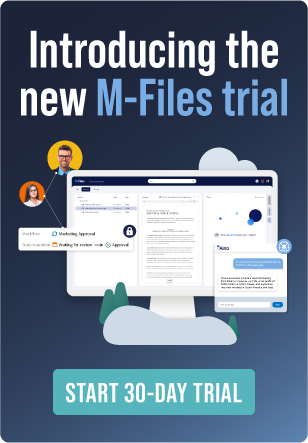How to Use Information Management to Secure a Competitive Advantage

By Antti Nivala on February 3, 2023
That old saying “knowledge is power” is one that all of us are very familiar with, whether it’s from work, school, or life. Gaining that insight or competitive edge by accessing and consuming information can help everyone make better-informed opinions and decisions and improve potential outcomes. But as more and more data is saved and consumed across organizations, it also becomes harder to find the right information when you need it.
When it comes to managing your information within an organization, that “insider’s gold” needs to be easily leveraged by your employees so that the latest and greatest insights can be a key part of what makes your company successful. But how can a company ensure that all of this is managed in a centralized location? The answer is information management.
Let’s look at the three keys to securing a competitive advantage with your company’s information.
1. Deploy federated search capabilities
What’s the use of having “insider’s gold” in your information if you can’t find it when you need it? This is where federated search comes in. Federated search allows knowledge workers to search multiple collections of text at the same time, making it easier for employees to find the data they need to excel at their jobs and improve business performance.
So how does it work? Most organizations have information stored on several different repositories – including network shares, hard disk drives, and cloud-based storage systems – that can soon become a complex, disparate web. Rather than wasting time searching for a particular document in each of these repositories, federated search allows knowledge workers to go through every repository at once. This increases the speed employees can retrieve information and act on the insight contained within it, which not only helps employees work smarter, but also improves client relationships by having access to the information they require at your fingertips.
2. Maximize the value of data
To become a successful digital organization in today’s increasingly turbulent business landscape, companies need a strategy to not only easily discover the information housed within the organization, but also maximize the value of critical data. We have already established that knowledge is power, but failure to value and manage data can leave knowledge work businesses open to losses because of improper security, problems with sharing and collaborating, and poor data quality.
By instituting an information management strategy, companies can often improve inefficiencies within their business and reveal opportunities to improve revenues. This can include enforcing better integration with marketing and sales systems to improve customer service or learning the market value of your data and offering new services based on that information, which all create additional revenue streams. However, the biggest gain from maximizing the value of your data can often be felt within your organization. Management can learn to recognize trends and pinpoint problems by using data as business intelligence, enhancing organizational efficiency, and establishing new strategies to help the business exceed its goals.
3. Keep your data secure and compliant
The best information management strategies do more than simply relieve companies of the burden of finding information. They enable employees to gain insight from that information and secure it to reduce business risk and ensure the company remains compliant with data privacy regulations. Most businesses consider compliance a burden, but it should be looked at as an opportunity to win and retain customers. Prioritizing data privacy protection can be a major competitive differentiator.
Businesses, especially in heavily regulated industries like finance or health care, need to set and enforce governance rules and company policies to ensure only authorized people can view and share sensitive information. The added benefit? Governance rules can make it easier to keep audit trails that can be accessed at any time. Therefore, when a customer or regulator asks for evidence about a potential data privacy issue, the organization can easily pull the information requested in real-time to avoid hefty fines.
Focusing on compliance not only increases customer loyalty by ensuring data rights are being respected, but it can also help with data cleansing, which can improve efficiency. Creating a data map of the organization can help streamline operations by eliminating “ROT” – redundant, obsolete, and trivial data that can eat up storage and bog down processes – and ensure customer information is kept up to date.
By deploying an effective information management strategy, organizations can use their information to make more informed business decisions, improve customer loyalty, and create new revenue streams. Information is the golden ticket to help increase competitive advantage and improve the bottom line – you just need to know how to use it and protect it.




